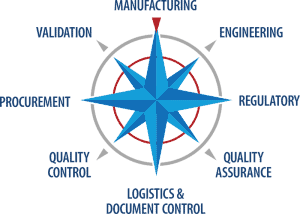An Introduction to Commissioning and Qualification
It can be difficult to coordinate the many activities involved in commissioning and qualification at biopharmaceutical manufacturing facilities. There is a ton of information to absorb at each phase of the process, and many stages to document and execute.
Below is a brief overview of commissioning and qualification as it relates to biopharma manufacturing.
What is Commissioning and Qualification?
The latest ISPE Baseline Pharmaceutical Engineering Guide simplifies the definitions by using “commissioning and qualification (C&Q)” to refer to the process of establishing and confirming that facilities, systems, utilities, and equipment are suitable for intended use. ISPE adjoining these two terms demonstrates the importance of integrating and unifying commissioning and qualification activities to make the process as safe, efficient, and cost-effective as possible.
Commissioning includes work completed by engineers and construction subcontractors when building, expanding, or renovating a biopharma manufacturing facility. Commissioning professionals review engineering designs, commission and decommission equipment and utilities, build risk assessment and management programs, and ensure alignment with qualification processes.
When performing commissioning activities, you’ll collect installation data, check systems functionality, and then circle back to correct any issues your teams have found.
Qualification is the process by which manufacturing facilities demonstrate that utilities and equipment will satisfy the requirements for their intended use. The qualification process is overseen by the Quality Unit, which has the ultimate authority to decide whether systems are suitable for the intended purpose.
When it comes time to execute the qualification process — which the ISPE Baseline Guide refers to as “verification” activities — there are three distinct types of qualification performed in biopharma manufacturing facilities:
- Installation Qualification (IQ): IQ involves documenting that you have received the correct manufacturing equipment for your facility and that you’ve installed it correctly. This level of documentation is necessary to establish a paper trail proving proper equipment procurement and installation.
- Operational Qualification (OQ): OQ tests if the installed equipment can perform according to the manufacturer’s intended ranges of performance. This type of qualification often includes operator training as part of the testing of settings and configurations.
- Performance Qualification (PQ): PQ is the last stage of qualification where your team will review IQ and OQ documentation and run tests in simulated real-world manufacturing conditions. After review, the quality team attempts to produce data and documentation that shows the installed equipment can perform in the conditions needed for manufacturing.
How is Commissioning and Qualification Performed?
The latest ISPE Baseline Guide incorporates language and principles from the ASTM E2500 Standard Guide, so you can use it as a comprehensive resource.
There are many (complicated!) intermediate steps in the performance of biopharma commissioning and qualification, but to summarize, you will commission the design of your facility using cGMP standards and qualify your utilities and equipment.
The critical last step in qualifying your utilities and equipment is to set up a system for maintaining the qualified status of your manufacturing processes by using data trends for accurate monitoring.
Why are Commissioning and Qualification Important?
Commissioning and qualification in biopharma is a big undertaking, but why is it so important? There are several reasons:
- Biopharma is highly regulated (FDA in 21 CFR Part 211); commissioning and qualification ensures compliance
- If done well, it facilitates regulatory inspections
- It helps discover issues with facility design and find the best, most compliant way to resolve them
- It tests equipment to see if it can perform efficiently and consistently in real manufacturing conditions
How to Make Commissioning and Qualification Run Smoothly
Commissioning and qualification in biopharma is a very involved process, but there are a few best practices you can implement to make it run smoothly at your facility.
Decide Who Will Be on the Commissioning and Qualification Project Team
Several departments will be involved in your project (manufacturing, operations, engineering, quality assurance, and quality control), so make sure they are a part of the project from the beginning. Get each department representative to weigh in from the start and at all stages.
Develop a Plan for the Project and Stick to It
Your specific facility and timeline will determine the type of plan you create for your project. Consult all departments when creating your plan and get feedback and sign-off. Once a plan is agreed on, stick to it!
Make Environmental Controls Part of the Project Plan
Ultimately, your goal is to produce biopharmaceutical products that are safe and effective. Controlling the environment in your manufacturing area is a big part of this, so make sure all of your other systems connect with your environmental monitoring system.
Get It Done Right: Contact ICQ to Get Started
Let us use our expertise to handle all of the complicated steps for you.


